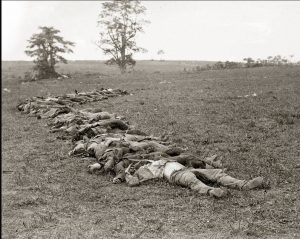Studying Two Wars, Two Centuries Apart
by admin | December 13, 2019 7:49 am
I ain’t gonna study war no more.
— Down By The Riverside [1]
[1]
The chorus of that old spiritual, which predates the Civil War, has been running through my head lately. It’s likely the result of the subject matter of books I recently finished, and the photography course I completed teaching earlier this week.
Matterhorn: A Novel of the Vietnam War, by Karl Marlantes, is the most gripping — and emotionally difficult to read — account of that conflict that I have read. Marlantes served as a Marine in Vietnam. The book jacket says he received the Navy Cross, Bronze Star, two Navy Commendation Medals for valor, two Purple Hearts and 10 air medals. This was his first novel, and it took him 30 years to complete it. Marlantes was dropped into a jungle in Vietnam at 23, and the protagonist of the novel is based on his experiences as a green lieutenant commanding a platoon. Matterhorn brings to the pages as gripping an account of what those young men faced in that conflict — misguided orders, unneeded sacrifices to capture a hill (Matterhorn) later abandoned and then recaptured, jungle rot, scarce food, and the black humor of soldiers hoping to survive while fighting a shadowy enemy. He has since written a nonfiction book – What It’s Like to Go to War. I am probably going to pass on reading that for now.
At the same time, as is my habit, I was reading The British Are Coming by Rick Atkinson. It is the first volume in a planned trilogy recounting the American revolution. Atkinson is the author of the much-acclaimed Liberation Trilogy about World War II, which I haven’t read. The British Are Coming covers the War for America, as he puts it, from 1775 – 1777, in more than 600 pages, including footnotes and bibliography. Without the benefit of any visual material except paintings, drawings and maps, Atkinson pays what is almost certainly the most vivid picture of that war. As historian Joseph Ellis, no slouch himself, wrote in a New York Times review, “Lurking behind all the assembled evidence, which Atkinson has somehow managed to read and digest in a remarkably short period of time, is a novelistic imagination that verges on the cinematic.”
Atkinson graphically recounts the utter brutality of a war, which when coupled with diseases such as smallpox and dysentery, swiftly killed its participants. Whether death came from being decapitated by an 8-pound cannonball or dying a hideous, disfigured death from smallpox, it came often and in large numbers on both sides. He paints a far-harsher picture of the actions of both the revolutionaries and the British, reinforced by German mercenaries.
At roughly the same time, I gave a lecture on the history of photography, which I touched on a few weeks back. One of my points was that, after the advent of photography, people could see actual images that depicted the horrors of war. At first, photographers only ventured onto the battlefield once the fighting had stopped. Photographers in the 1860s used daguerreotypes. Those were created by putting a light-sensitive coating on glass. The exposure took so long it would not stop action, so people weren’t captured on the daguerreotype. Besides, the photographer likely would have become a casualty as well, standing on a battle line with a bulky camera and tripod. The images first seen from the Civil War, for example, are of killing fields strewn with bodies. The first actual photo, far as we know, taken of a battle as it occurred was in 1870, in the Franco-Prussian war. The technology had improved enough to capture battle scenes. No longer would people only have idealized paintings and woodcuts of battles as visual images.
Doubtless, some idealists hoped such graphic images might forestall future warfare. It didn’t, of course. We have become largely inured to grisly images of war. There is something about reading at the same time a pair of books on wars fought nearly two centuries apart that struck a nerve in me. I don’t know if I’m going to study war anymore — at least not until Atkinson’s second volume arrives.
- [Image]: http://garyborders.com/pages/studying-two-wars-two-centuries-apart/images-of-war/
Source URL: https://garyborders.com/pages/studying-two-wars-two-centuries-apart/